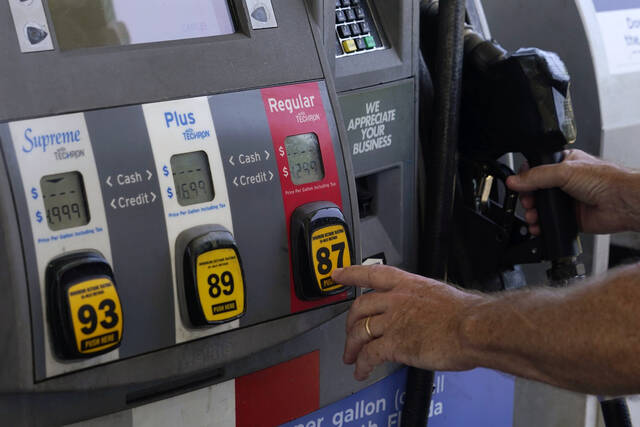Editorial: What is the fix for gas price increases?
The price of gas is rising faster than almost anything — except the profits of oil companies.
The average price per gallon in the greater Pittsburgh area topped $5 for the first time last week, with Somerset up to $5.08. The national average is over $5, too. It’s a 35% increase over the price of that same gallon in 2021.
The increase in gas prices is a bigger problem than the inflation bloating other costs — for multiple reasons. The price of eggs is up even more — about 76%, according to the Bureau of Labor Statistics. But people can opt to eat cereal for breakfast or substitute bananas in a muffin recipe. They aren’t obligated to buy eggs.
But if you live 20 miles from work, you can’t just choose not to buy gas. Walking isn’t a viable option. Mass transit is not always an option, especially the farther you get from a city center.
There is also the fact that higher gas prices can be a driving force behind the rise in other costs. In Pennsylvania alone, $460 billion of goods are shipped by truck. That’s just the stuff that starts its journey here, not the stuff coming from California or the trucks passing through from New York.
This is a global issue that started with the pandemic and is complicated by the war in Ukraine. In the United Kingdom, the price Friday was $8.60 per gallon. In Denmark, a gallon is $10. In Hong Kong, $11.21. Only countries swimming in oil, such as Kuwait and Saudi Arabia, are showing prices under $3 a gallon.
So everyone is suffering with higher gas prices, right? Not exactly.
The five largest oil companies in the U.S. are posting record profits. In the first quarter of 2022, BP, Chevron, Conoco Phillips, ExxonMobil and Shell raked in $35 billion after expenses.
They also have the ability to bring down the price at the pump by putting more gas in play. The biggest problem with gas prices now is supply. On Friday, President Biden accused oil companies of keeping supply low to keep prices high.
“Exxon made more money than God this year,” he said. “They aren’t drilling. Why aren’t they drilling? Because they’re making more money not drilling.”
That’s about production. What about the people who are buying the gas — and the other things with inflated prices?
On June 1, Gov. Tom Wolf called on state lawmakers to act on a proposal to give $2,000 payments to Pennsylvania households making under $80,000 a year. That would be the majority, as the U.S. Census Bureau puts the median household income at $63,627.
Does the state have the money? Technically. There is $2.2 billion in stimulus money waiting to be spent, but there are plenty of ways that could be used to fill needs the state already has. The pandemic brought plenty of needs into sharp focus, including child care, nursing homes and education. There are environmental problems to fix. The pile of stimulus money available will not do it all.
Whether the Legislature does what Wolf wants — and that usually seems unlikely — the best case is that $2,000 just gets pulled from other things that would benefit the same Pennsylvanians.
What every household needs is for gas prices to drop, but it seems like, for that to happen, we all have to wait for oil companies to be OK making less profit.
Remove the ads from your TribLIVE reading experience but still support the journalists who create the content with TribLIVE Ad-Free.

